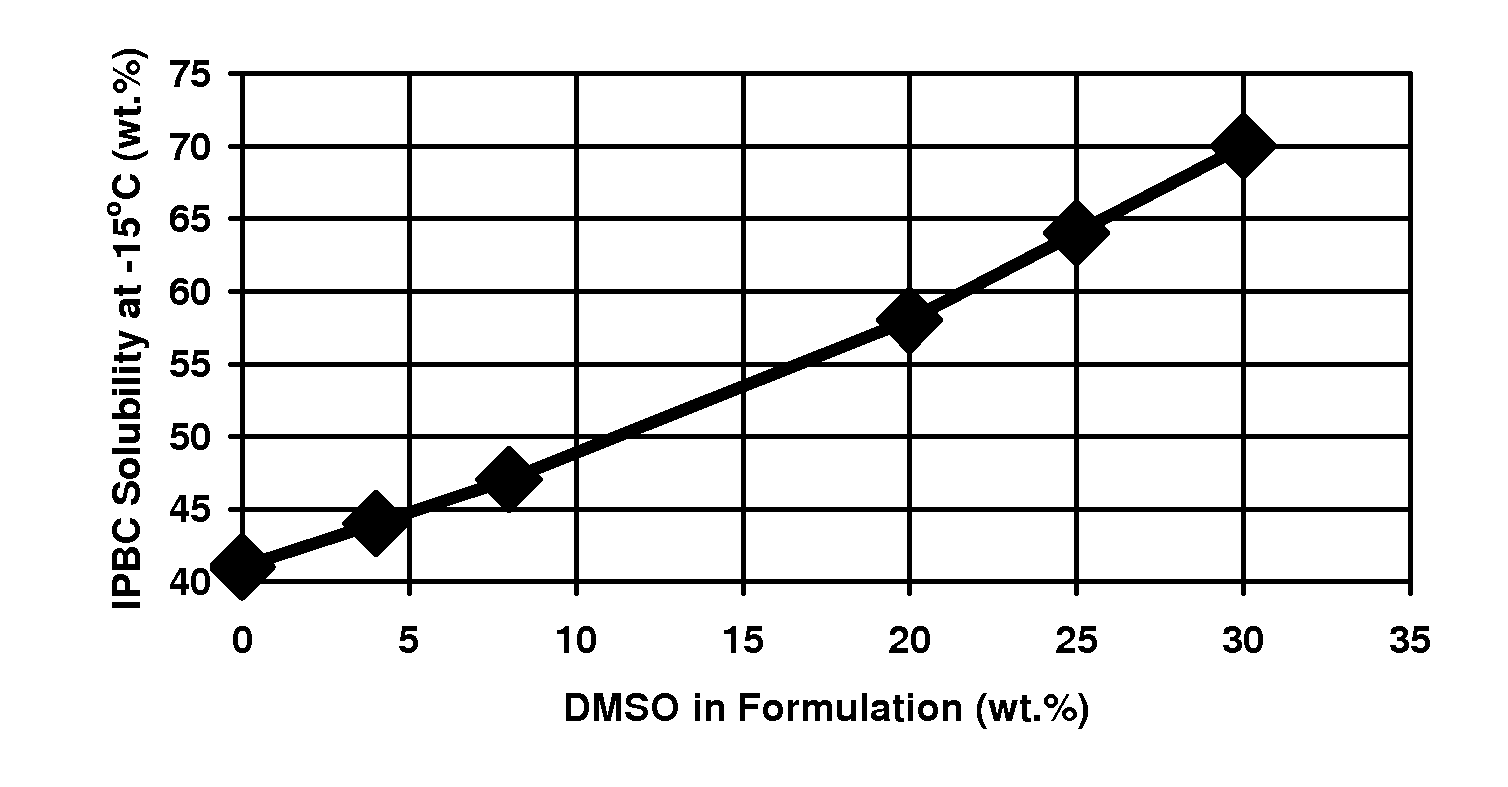Stable, low voc, low viscous biocidal formulations and method of making such formulations
a biocidal formulation and low viscosity technology, applied in textiles and paper, paper after-treatment, antifouling/underwater paints, etc., can solve the problems of high viscosity, difficult to effectively and uniformly disperse the biocide in the matrix undergoing treatment, and less desirable use of paints and coatings
- Summary
- Abstract
- Description
- Claims
- Application Information
AI Technical Summary
Benefits of technology
Problems solved by technology
Method used
Image
Examples
example 1
Viscosities of IPBC Solutions in MPEG Vs PEG
[0041]This example compares viscosities of formulations containing MPEG-350 according to the invention, with non-invention formulations containing PEG-400. Samples are prepared by weighing the required amount of IPBC and solvent, MPEG-350 or PEG-400, into a vial to achieve the desired weight fraction of IPBC in the liquid carrier. The IPBC / solvent mixture is warmed to 70° C. while shaking to accelerate the dissolution process. Once the IPBC is dissolved, the solution is cooled to room temperature for viscosity measurement.
[0042]A Brookfield Cap 2000+ viscometer equipped with spindle 10 is calibrated using a known standard. The spindle is charged with the IPBC solution to be measured and when the sample temperature is stable at 25° C., the viscosity is measured with a spindle speed of 100 rpm and a shear rate of 500 sec−1. Data is provided in Table 1. In Table 1, formulations based on PEG-400 are for comparative purposes.
TABLE 1Brookfield V...
examples 2-6
[0043]The biocidal solutions of Examples 2-6 are prepared according the general method outlined below:
[0044]In a 100 ml beaker is added about 25 ml of solvent, and the weight is recorded to four significant digits. The beaker is heated to 40-60° C. (depending on the active being tested) in a water bath. The solute of interest is added stepwise (all aliquot weights are recorded to four significant digits) until saturation is achieved. Once the solid remains undissolved, back-titration with known weights of solvent are performed until the solution is clear.
[0045]Brookfield viscosity measurements are obtained at 23° C. using the spindles and rpms noted in the tables below.
[0046]VOC measurements are made according to the following procedure: to an oven-dried, tared aluminum pan is added 0.5 g of the test solution, weighed to four decimal places. Approximately 3 g of water are added to the test solution. The pan is heated in a vented oven for 1 hour at 110° C.±5° C. After removal from th...
example 2
VOC / Viscosity of IPBC
[0047]The volatile organic content of formulations of IPBC in MPEG-350, PEG-400, NMP, are evaluated, as well as a commercial IPBC sample. Data are provided in Table 2. In Table 2, formulations based on PEG-400 or NMP are for comparative purposes.
TABLE 2VOC Levels,Brookfield Viscosity, cPIPBC Formulation% by wtSpindle #4 @ 100 rpm, 23° C.47% IPBC in MPEG 3506.810840% IPBC in PEG 4004.818440% IPBC in NMP65.82240% IPBC in MPEG 3504.396Commercial sample of62.5NA40% IPBC(Polyphase AF1)
[0048]As can be seen, MPEG enables the formulation of low VOC solutions of IPBC. As also demonstrated, IPBC can be formulated to a higher active concentration and lower viscosity in MPEG as compared to PEG.
PUM
| Property | Measurement | Unit |
|---|---|---|
| wt. % | aaaaa | aaaaa |
| weight % | aaaaa | aaaaa |
| weight percent | aaaaa | aaaaa |
Abstract
Description
Claims
Application Information
 Login to View More
Login to View More - R&D
- Intellectual Property
- Life Sciences
- Materials
- Tech Scout
- Unparalleled Data Quality
- Higher Quality Content
- 60% Fewer Hallucinations
Browse by: Latest US Patents, China's latest patents, Technical Efficacy Thesaurus, Application Domain, Technology Topic, Popular Technical Reports.
© 2025 PatSnap. All rights reserved.Legal|Privacy policy|Modern Slavery Act Transparency Statement|Sitemap|About US| Contact US: help@patsnap.com


